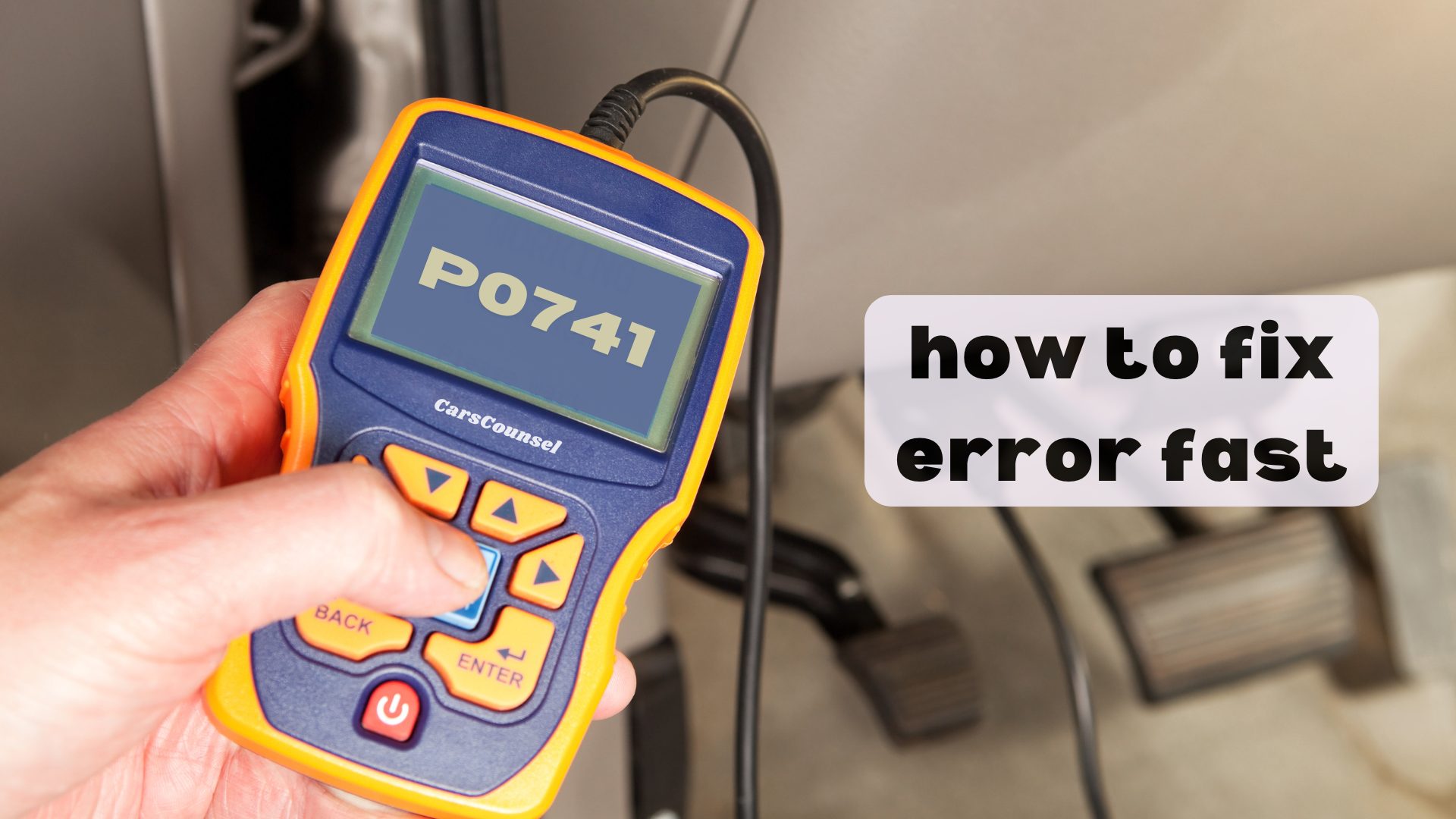If you’ve seen the P0741 code on your car, it means there’s a problem with the torque converter clutch, which can mess with your car’s performance and fuel efficiency.
To fix this fast, first use a diagnostic scanner to confirm the OBD2 Codes and check the torque converter clutch solenoid for any issues.
But don’t stop there. Have you looked at your transmission fluid? Make sure it’s at the right level and in good condition.
After taking care of these, there are more steps to follow to fully fix the problem. Let’s go over them.

Quick Navigation
Key Takeaways
- Replace the bad torque converter clutch solenoid to get it working right again.
- Check and fill up the transmission fluid for best performance.
- Look for and fix any broken wires or electrical connections.
- Use a diagnostic scanner to clear the P0741 code after fixing it.
What Is Code P0741?
Code P0741 means there’s a problem with the torque converter clutch circuit in your automatic transmission. This part helps transfer power from the engine to the transmission. If the clutch circuit isn’t working right, it messes up this power transfer and causes transmission problems.
To fix it, first check if the torque converter clutch solenoid is working. If this solenoid fails, the clutch won’t engage or disengage like it should.
Next, look at the wiring to see if there are any breaks or damage. Also, make sure the transmission fluid level is where it should be, as low fluid can make the problem worse.
Symptoms of P0741
The symptoms of P0741 often include noticeable delays when shifting gears and rough transitions between gears. You’ll also see the Check Engine Light (CEL) on your dashboard.
You might feel a lag when changing gears, which points to problems with the clutch engaging. The torque converter may not lock up properly, leading to poor power transfer.
You could also notice high RPMs while driving at steady speeds because the torque converter clutch isn’t engaging. Additionally, there might be shuddering during acceleration.
These signs indicate that the transmission is having trouble managing power. Fixing these problems quickly can help keep your vehicle running well and prevent further transmission damage.
Common Causes
Common Causes of P0741 Code
One of the main reasons for a P0741 code is a bad torque converter clutch solenoid, which can cause the car to stall and shift gears roughly. Low transmission fluid is another big issue, leading to slipping and overheating. If the valve body is faulty, it messes up the fluid flow and causes rough shifts. Wiring problems, especially in cars like the Nissan Altima, can lead to voltage loss to the solenoid, making things worse. Lastly, general wear and tear, including old parts and transmission overheating, can also set off the P0741 code.
| Cause | Symptoms | Common Models |
|---|---|---|
| Torque Converter Clutch Solenoid | Stalling, rough shifting | Various |
| Low Transmission Fluid | Slipping, overheating | Toyota Camry |
| Faulty Valve Body | Rough shifts | Ford Escape |
| Wiring Issues | Voltage loss to solenoid | Nissan Altima |
Diagnosing P0741
To properly diagnose the P0741 code, start by using a diagnostic scanner to get the code and see if there are any other related codes.
Then, look at the torque converter to check for any signs of damage or wear.
Use diagnostic tools to test the torque converter clutch solenoid.
Next, check the transmission fluid level with the dipstick to make sure it’s at the right level and in good condition.
Take the car for a drive to see if there are any symptoms like stalling or rough shifting.
Finally, inspect all electrical connections and wiring, especially those related to the torque converter, to make sure everything is in good shape.
This step-by-step approach will help you find the problem accurately.
Using a Diagnostic Scanner
First, plug the diagnostic scanner into your car’s OBD-II port, usually found under the dashboard.
Turn on the scanner and switch the ignition to the ‘on’ position without starting the engine.
Use the scanner to find the code retrieval option. The scanner will read the error codes stored in your car’s computer.
Look for the P0741 code, which means there’s an issue with the torque converter clutch circuit.
Make a note of any other codes that show up, as they can give you more information about the problem.
After you’ve got the codes, you can clear them and take the car for a test drive.
If the P0741 code comes back, it confirms there’s still an issue.
Inspecting the Torque Converter
Start by looking over the torque converter for any signs of damage or wear, like cracks, leaks, or discoloration. Check the whole surface and all connection points carefully. If you see anything unusual, it might mean the torque converter needs maintenance.
Then, take a close look at the clutch engagement mechanism. Make sure the clutch plates aren’t too worn out or damaged. Turn the torque converter by hand to see if it moves smoothly; if you feel any resistance or roughness, there could be internal problems.
Lastly, check the mounting bolts and connections to make sure they’re tight and properly aligned. Taking the time to inspect these areas thoroughly will help ensure the torque converter works well, avoiding further transmission issues related to the P0741 code.
Checking Transmission Fluid
After thoroughly checking the torque converter, the next step is to check the transmission fluid level to ensure it meets the required standards for optimal transmission performance. Proper transmission maintenance is key to avoiding issues like the P0741 code.
- Find the Dipstick: Locate the transmission dipstick, usually found near the engine bay.
- Check Fluid Level: Pull out the dipstick, wipe it clean, put it back in, and then pull it out again to see the fluid level.
- Inspect Fluid Quality: Make sure the fluid is clear and reddish without any burnt smell or debris.
Keeping the fluid in good condition ensures smooth transmission operation.
Road Testing
Taking your car for a drive can help you spot issues like stalling, rough shifting, or other signs of a P0741 code problem.
Begin by driving in different road conditions to see how your car reacts. Slowly speed up and slow down, and pay attention to any delays or rough shifting. Drive like you normally do to get accurate results.
Test your car on both city streets and highways to see if the symptoms change with speed. Listen for any vibrations or strange noises when the torque converter clutch should be engaging or disengaging.
This step-by-step road test helps you find problems related to the P0741 code, making it easier to figure out the right repairs.
Electrical Connections
Check all the electrical connections for the torque converter clutch. Look for signs of wear, rust, or loose parts.
It’s crucial to make sure the wiring is in good shape to keep the solenoid working. Here’s what to do:
- Check Connectors: Make sure all plugs are tight and not rusty. Clean or replace them if needed.
- Inspect Wiring: Look for any frayed, cut, or exposed wires. Replace any damaged parts to avoid losing power.
- Test Voltage: Use a multimeter to check if the right voltage is reaching the solenoid.
Fixing P0741
To fix the P0741 code, start by replacing the torque converter clutch solenoid if it’s faulty.
First, perform basic transmission maintenance by draining the transmission fluid and removing the fluid pan.
Find the solenoid, disconnect it, and put in the new one.
Make sure all connections are tight before putting the fluid pan back on and refilling with new transmission fluid.
Next, clear the code using a diagnostic scanner and take the car for a test drive to make sure the problem is fixed.
If the issue continues, check the valve body and wiring for other problems.
Regular transmission maintenance and replacing the solenoid when needed can help prevent future issues and keep your car running smoothly.
More OBD-II Codes
Frequently Asked Questions
Can Driving With a P0741 Code Damage the Transmission Further?
Yes, driving with a P0741 code can harm the transmission even more. You’ll cause extra wear and tear and might contaminate the transmission fluid. Fix problems like bad solenoids or low fluid levels right away to avoid expensive repairs.
What Are the Costs Associated With Fixing the P0741 Code?
Fixing the P0741 code can cost you anywhere from $200 to $2,500. This usually involves replacing parts like solenoids or valve bodies. Mechanics use diagnostic tools to find the exact problem, making sure you don’t pay for things you don’t need.
How Long Does It Typically Take to Repair a P0741-Related Issue?
When dealing with P0741-related problems, time is important. Usually, it takes about 3 to 5 hours to fix the issue. You’ll begin with diagnosing the problem, which includes checking the fluid and inspecting the solenoids, before making any repairs or replacements.
Can I Fix the P0741 Code Issue Myself Without Professional Help?
Yes, you can try to fix the P0741 code issue yourself if you have a basic understanding of transmissions. Start by checking the transmission fluid, looking at the torque converter clutch solenoid, and inspecting the wiring. Use a diagnostic scanner to get the codes and help you figure out the next steps.
What Is the Likelihood of the P0741 Code Recurring After Repair?
Think of it like a song on repeat: the P0741 code can come back if you don’t fix everything that caused it in the first place. How well the repair works depends on careful checking, swapping out bad parts, and keeping up with regular maintenance. Make sure you do each step carefully to lower the chances of it happening again.
Conclusion
You won’t believe how easy it is to tackle the P0741 code!
Just grab a diagnostic scanner to quickly find the issue. Check the torque converter clutch solenoid and make sure your transmission fluid is in good condition.
Once you’ve done that, clear the error codes and take your car for a test drive. Problem solved!
Don’t let this pesky code ruin your day; fix it fast and keep driving without worries.

